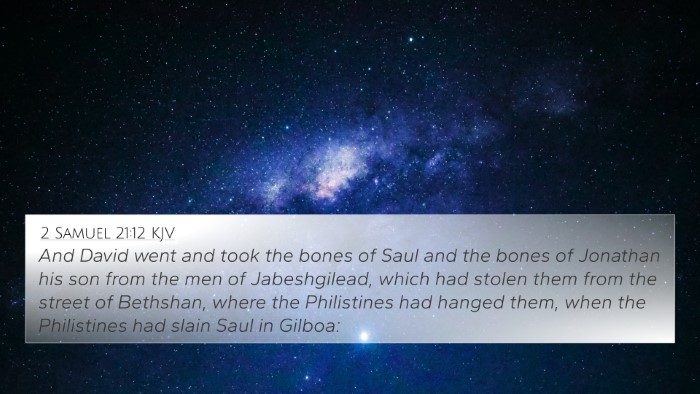Understanding 1 Samuel 31:10
Verse Context: 1 Samuel 31:10 recounts the tragic end of King Saul, Israel's first king. The verse states, "And they put his armor in the house of Ashtaroth: and they fastened his body to the wall of Bethshan." This moment marks a significant point in Israel's history, illustrating the consequences of Saul's disobedience and God's judgment.
Summary of Commentary Insights
This verse has been examined by numerous scholars, including Matthew Henry, Albert Barnes, and Adam Clarke. Their insights help illuminate its meaning and significance:
- Matthew Henry: He emphasizes the deplorable state of Saul's death and the disgrace it brought upon Israel. Henry points out that the Philistines exhibited Saul's armor in their temples as a trophy, which signifies the ultimate defeat of Saul and the divine judgment on his kingship.
- Albert Barnes: Barnes highlights the cultural practices surrounding death in the ancient Near East. He explains that hanging Saul's body was intended to serve as a warning against the Israelites. Furthermore, Barnes emphasizes the Philistines' victory here as a stark contrast to Israel's past glories under Saul's reign.
- Adam Clarke: Clarke notes that the act of displaying Saul's armor was meant to celebrate Philistine triumph. He elaborates on the implications of such a victory over the long-standing enemy, detailing how Saul’s failure led to a national crisis for Israel.
Key Themes and Connections
The verse underscores several key themes in the larger narrative of Scripture:
- Divine Judgment: This event reflects how God’s displeasure with Saul for disobedience leads to dire consequences.
- Symbol of Defeat: The display of Saul's armor becomes a powerful symbol of the fall of Israel's leadership.
- Contrast in Legacy: Saul’s legacy, which began with promise, ends with dishonor, contrasting sharply with the future reign of David.
- National Crisis: The Philistine triumph signifies a period of turmoil for Israel, setting the stage for the emergence of David.
Bible Verse Cross-References
This passage can be connected to several other scriptures that reflect its themes and historical context:
- 1 Samuel 10:1: Saul is anointed by Samuel, marking the beginning of his kingship.
- 1 Chronicles 10:9-10: A parallel account of Saul’s death and the subsequent actions of the Philistines regarding his body.
- 2 Samuel 1:17-27: David's lament for Saul emphasizes the tragic end and sorrow over Saul’s fall.
- Galatians 6:7: Illustrates the principle of reaping what one sows, echoing Saul’s disastrous choices leading to his demise.
- 1 Corinthians 10:12: Warns against pride, reminding believers of the importance of humility and obedience to God, relevant to Saul's arrogance.
- Hebrews 11:32-34: References heroes of faith, including David, contrasting their faithfulness with Saul’s failures.
- Job 20:5: Highlights the transient nature of the wicked’s triumph, aligning with the eventual fall of Saul.
Thematic Bible Verse Connections
We find that 1 Samuel 31:10 connects powerfully to several biblical themes including:
- God’s Sovereignty over leaders and nations
- The importance of faithfulness in leadership
- Consequences of sin in the lives of individuals and nations
- Covenant faithfulness and the fulfillment of God’s promises amidst human failure
Exploring Cross-Referencing Methods
Engaging with the Bible through cross-referencing methods can enhance understanding of such verses:
- Utilizing a Bible concordance to locate terms and themes found in 1 Samuel 31:10 can aid in deeper study.
- Employing a cross-reference Bible study can help identify parallels within the story of Saul and the greater narrative of Scripture.
- Using tools for Bible cross-referencing, like online study resources or a physical cross-reference Bible, can enrich study.
- Learn how to use Bible cross-references effectively to link verses and grasp their broader implications.
Conclusion
1 Samuel 31:10 serves not just as a historical account but as a pivotal lesson in the dangers of disobedience and the assurance of God’s judgment. By exploring biblical cross-references, the connections between biblical texts become clearer, helping readers to navigate the complexities of scripture effectively.








